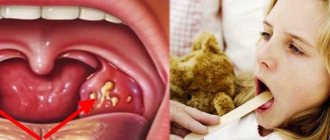Symptoms of purulent sore throat
The disease begins acutely. Almost simultaneously, general and local symptoms appear, which reach their maximum development on the second day1,4.
General symptoms:
- fever up to 39-400 C1;
- chills;
- headache;
- weakness;
- feeling overwhelmed;
- aches and pain in muscles and joints;
- Children may have nausea, vomiting and abdominal pain1,4.
Local symptoms:
- sore throat that gets worse when swallowing and sometimes radiates to the temple or ear;
- dryness, soreness and soreness in the throat;
- increased secretion of saliva;
- spasm of the masticatory muscles on the side of inflammation is possible, which prevents you from opening your mouth wide;
- enlargement and tenderness of the cervical lymph nodes1.
Up to contents
What does a purulent sore throat look like?
The picture that can be seen when examining the throat depends on the form of the disease.
Follicular tonsillitis
The functional tissue of the tonsils consists of follicles - individual “islands” of lymphoid tissue. Follicular tonsillitis is a purulent inflammation of the follicles1.
Initially, the tonsils swell, increase in size, and become red. Then yellow-white dots begin to appear on the red background - pus, which accumulates in the follicles1,3.
Lacunar tonsillitis
Lacunar tonsillitis begins in the same way as follicular tonsillitis, with enlargement and redness of the tonsils. Then pus appears in their numerous depressions (lacunae). It appears on the surface in the form of yellowish-white islands, which gradually increase in size and merge with each other1,3.
Up to contents
Why does chronic adenoiditis provoke frequent sore throats?
The cause of frequent sore throats is often a complete or partial block of nasal breathing caused by enlarged adenoid vegetations. Difficulty in nasal breathing provokes mouth breathing, while unheated, undisinfected air passes through the mouth, which helps to cool the tonsil tissue, increases the immune load on the tonsil tissue, and also often becomes contaminated with pathogenic flora due to the leakage of mucopurulent discharge along the back wall of the pharynx from inflamed areas. adenoids, and as a result, decompensation and the occurrence of purulent inflammation in the tonsil tissue.
Causes of purulent sore throat
The immediate cause of inflammation of the tonsils is the penetration of infectious agents into them - viruses, bacteria, fungi. However, the disease develops mainly against the background of a decrease in the body’s defenses1.
The impetus for the development of tonsillitis can be:
- hypothermia: the disease occurs especially often in the autumn-winter and spring periods1;
- unbalanced diet, leading to hypovitaminosis and weakened immunity3;
- tonsil injuries, for example, from rough food3;
- nervous system disorders3;
- inflammatory diseases of the nose, paranasal sinuses, oral cavity3.
The palatine tonsils are located at the intersection of the respiratory and digestive tracts. Therefore, they can be affected by microbes from the mouth, nose and throat1.
Most often, purulent inflammation of the tonsils is associated with streptococcal infection2. The most severe forms of the disease are caused by beta-hemolytic streptococcus of group A2,3,4. It is found in 15% of adults with purulent tonsillitis and in 20-30% of children2.
Streptococcal infection is contagious. Patients and even those who have recovered from tonsillitis can be a source of infection for healthy people for 10-12 days1.
Streptococcus often leads to rheumatic diseases and damage to internal organs. Therefore, if signs of purulent tonsillitis appear, you should definitely consult a doctor to find out which microorganism caused the inflammation. Today, rapid tests are used to diagnose streptococcal infections, which show results with an accuracy of 99% within 15-20 minutes5.
Viral tonsillitis is usually caused by pathogens of acute respiratory infections:
- adenoviruses;
- influenza and parainfluenza viruses;
- rhinoviruses1,3;
- herpes simplex virus;
- Epstein–Barr virus;
- cytomegalovirus4 and others.
Sore throat is one of the manifestations of measles, scarlet fever, infectious mononucleosis and blood diseases1. Only a specialist can understand the intricacies of the disease.
Up to contents
Why does the temperature rise
Fever accompanies most infectious diseases, including acute tonsillitis2,3. The processes that cause an increase in body temperature are quite well studied. They are triggered by special substances pyrogens, which can enter the body from the outside (exogenous pyrogens) or be synthesized inside it (endogenous pyrogens).
Endogenous pyrogens are substances that enter the bloodstream during the destruction of immune cells and cells of the inflamed mucous membrane of the throat2,3.
Exogenous pyrogens in the case of tonsillitis can be various microorganisms: viruses, bacteria, fungi3. In children aged 3 months to 3 years, tonsillitis most often develops with mixed herpesvirus infections3. When a child reaches the age of 3-7 years, viruses give way to bacteria, and in 30% of cases the disease is caused by group A3 beta-hemolytic streptococcus. In addition, the tonsils are often affected by streptococci of other groups, staphylococci, etc.1 In adults, acute tonsillitis is often viral and accompanies ARVI1.
Exogenous and endogenous pyrogens affect the thermoregulation center located in the brain2,3. As a result, he begins to perceive normal body temperature as lower and increases the level of heat production, which leads to an increase in body temperature2,3.
Up to contents
How long does a sore throat last?
The duration of the disease depends on its form and severity. The total duration usually does not exceed 7 days4.
Regardless of how long a purulent sore throat is treated, the doctor states recovery only 5 days after the temperature normalizes. In this case, the patient’s sore throat should disappear, and the lymph nodes should become painless. In addition, the results of blood tests, urine tests and electrocardiograms are always taken into account3.
Up to contents
Treatment of purulent sore throat in adults and children
A doctor should treat tonsillitis. He will determine the form of the disease and prescribe the necessary medications. Self-medication can lead to a protracted course of the disease and complications.
In order not to infect others, a patient with acute tonsillitis must be isolated and given separate dishes and a towel1.
During the period of fever, strict bed rest is indicated, and after the temperature drops, semi-bed rest and home rest1,3.
Plenty of warm drinks and gentle nutrition are recommended, which does not irritate a sore throat. Typically, doctors recommend a dairy-plant diet with a limited amount of carbohydrates and a high content of vitamins1,3.
Drug treatment includes general and local drugs.
To fight infections and inflammation and relieve the symptoms of tonsillitis, your doctor may prescribe the following medications:
- antibiotics;
- anti-inflammatory;
- antiallergic;
- antipyretics1,3.
Local treatment of follicular and lacunar tonsillitis includes gargling or irrigating the throat, as well as the use of absorbable tablets with antiseptic, anti-inflammatory and analgesic effects. The goal is to mechanically cleanse the tonsils of pus, fight the pathogen, sore throat and inflammation2.
Up to contents
Treatment
To avoid infecting others, you need to stay at home if treatment for sore throat will be carried out at home, or quickly go to the hospital if therapy involves a hospital stay.
The room should be ventilated as often as possible, and if possible, ultraviolet irradiation and wet cleaning should be carried out. Dishes and towels must be strictly individual.
Therapy for tonsillitis includes the creation of a gentle regime, general and local therapy.
Gentle mode
- At the beginning of the illness and the first couple of days after the temperature normalizes, it is better to stay in bed1. Then, when the fever goes away, you need to stay home and avoid physical activity.
- Increased temperature promotes increased sweating. Drinking plenty of drinks - will help reduce the symptoms of intoxication and avoid dehydration . Traditional treatment of sore throat with milk and honey is contraindicated. Sweet milk is an ideal breeding ground for bacteria; they multiply quickly, and this aggravates the course of the disease1.
- Food must be thermally processed, liquid or crushed, unsalted and unsweetened, without the addition of spices and spices1. It is better to choose easily digestible vegetable and dairy dishes with a low content of simple carbohydrates, boiled, stewed, steamed1.
Systemic drug therapy
Regardless of the severity of the condition, streptococcal tonsillitis is an indication for antibiotic therapy in the form of tablets or injections1,2,4. Therefore, if you have a sore throat, you should consult a doctor.
Antibiotics are especially important in the treatment of sore throat in children and people with weakened immune systems. They help prevent the development of complications2.
The choice of antibiotic and its dosage is determined by the doctor. In particular, beta-hemolytic streptococcus is sensitive to the latest generation of penicillin and macrolides1,2. The duration of treatment for sore throat with fever in both adults and children is on average 7 days2. Severe condition is an indication for hospitalization in an infectious diseases hospital, injection or drip administration of antibiotics2.
Antibiotics kill not only pathogenic bacteria, but also beneficial microflora of the oral cavity and digestive tract, which can trigger the development of candidiasis. To prevent it, antifungal drugs . They are also used to treat fungal tonsillitis, which usually occurs in patients with severely weakened immunity, for example, due to AIDS or taking medications that suppress the immune system2,5.
Non-steroidal anti-inflammatory drugs help to quickly stop the inflammatory process and fever, and reduce pain in the throat.
Desensitizing drugs are indicated to prevent allergies and autoimmune complications2.
Local therapy
Gargling with saline (sea salt, soda) solutions and antiseptic solutions helps to speed up the cleansing of the tonsils2,3. Traditional medicine suggests using infusions and decoctions of medicinal plants, for example, chamomile or calendula. Traditional medicine has more effective means - special preparations for gargling2,3, such as HEXORAL®. In the treatment of mild forms of viral tonsillitis, they are used as the main remedy to prevent the development of bacterial inflammation of the tonsils3, in other cases they become an addition to systemic antibacterial therapy.
The main active ingredient of the preparations HEXORAL® SOLUTION and HEXORAL® AEROSOL is the antiseptic hexetidine, which has antiseptic, antifungal, analgesic, hemostatic and deodorizing effects6.
HEXORAL® solution/aerosol:
- active against gram-positive bacteria, which include bethemolytic streptococcus, and fungi of the genus Candida, which are activated when immunity is reduced and antibiotics are used6;
- has a high safety profile, due to which it can be used not only in adults, but also in children from 3 years old6;
- relieves painful sensations when swallowing6;
- valid up to 12 hours6.
HEXORAL® TABS and TABS CLASSIC contain antiseptics with a wide spectrum of antimicrobial action. HEXORAL® TABS also contains a local anesthetic that helps relieve sore throat7. Various aromatic oils give the tablets a pleasant taste and aroma. “Mint” HEXORAL® TABS can be used in the treatment of children aged 4 years and older7. HEXORAL® TABS CLASSIC comes in orange, lemon, honey-lemon, and blackcurrant flavors and is approved for use from the age of six7.
HEXORAL® TABS EXTRA based on amylmetacresol, dichlorobenzyl alcohol and lidocaine has an antiseptic effect and, being active against most gram-positive and gram-negative bacteria and fungi, reduces tissue swelling and sore throat8. The drug is approved for use from 12 years of age8.
Indicators of recovery: normal body temperature for 5 days, disappearance of pain in the throat and when palpating the lymph nodes, normalization of blood counts and absence of complications1.
Up to contents
Consequences of purulent sore throat
Acute tonsillitis can occur with complications. They are usually divided into local and general.
Local complications:
- paratonsillar abscess - an abscess that forms outside the tonsil when infection penetrates into the surrounding tissue;
- acute otitis media – inflammation of the middle ear;
- acute laryngitis - inflammation of the larynx;
- cervical lymphadenitis – inflammation of the lymph nodes1.
General complications occur more often with streptococcal sore throat4, these include:
- rheumatism;
- rheumatoid arthritis;
- myocarditis;
- polyarthritis;
- glomerulonephritis and pyelonephritis;
- pneumonia and others1.
Up to contents
Complications
It is necessary to take angina very seriously, since this disease can cause serious complications on the heart and joints in the form of rheumatism, the kidneys can be affected and glomerulonephritis occurs. If you ignore the problem, sore throat may develop into a chronic form, which is called chronic tonsillitis. Lack of timely treatment can lead to abscess of the retropharyngeal space, sinusitis and sinusitis, and otitis media. Purulent inflammation of the neck and inflammation of the mediastinal organs are very dangerous conditions, often resulting in death. Also characteristic are autoimmune lesions of the heart and kidneys, meningitis, sepsis, and rheumatoid arthritis.
Hexoral against purulent sore throat
For acute tonsillitis, all drugs from the HEXORAL® line can be used.
You can treat the throat with a sore throat (acute tonsillitis) using HEXORAL® spray based on hexethidine. It allows you to evenly cover the surface of the mucous membrane of the tonsils and pharynx, which contributes to a more effective fight against infection8. A solution of HEXORAL® with hexethidine and a combination of essential oils7 may be suitable for gargling.
The use of hexetidine preparations is prescribed in clinical guidelines for the treatment of acute tonsillopharyngitis2. Hexetidine is an antiseptic that is active against most bacteria, herpes simplex viruses type 1, influenza A, PC virus that affects the respiratory tract, and fungi. In addition, it has a mild analgesic effect7.
Both HEXORAL® spray and solution are approved for use for local treatment of tonsillitis in adults and children over three years of age7,8.
Lozenges with a neutral mint flavor HEXORAL® TABS based on chlorhexidine and benzocaine have antiseptic properties and analgesic properties. They are approved for use in adults and children aged 4 years and older9.
For adults and children over 6 years old, HEXORAL® TABS CLASSIC is available with the flavors of orange, black currant, lemon and honey. It is based on a combination of the antiseptics amylmetacresol and dichlorobenzyl alcohol, which help in the fight against tonsillitis pathogens10.
HEXORAL® TABS EXTRA may be suitable for children over 12 years of age and adults. In addition to the antiseptic component, it contains lidocaine, which can relieve even severe sore throat11.
The information in this article is for reference only and does not replace professional advice from a doctor. To make a diagnosis and prescribe treatment, consult a qualified specialist.
Up to contents
Literature
- Dergachev V. S. Angina. Clinic, diagnosis and treatment algorithm. Choice of local antibacterial therapy // Regular issues of “RMZh” / No. 18. – 2007. – P. 1350.
- Clinical recommendations Acute tonsillopharyngitis // National Medical Association of Otorhinolaryngologists / 2016.
- Kunelskaya N.L., Turovsky A.B., Kudryavtseva Yu.S. Sore throats: diagnosis and treatment // General Medicine / No. 3. – 2010. – P. 4-9.
- Krasnova E.I., Khokhlova N.I. Differential diagnosis and treatment tactics for acute tonsillitis (tonsillitis) at the present stage // Attending physician / No. 11. – 2021. – P. 58-63.
- Shcherbakova M. Yu., Belov B. S. A-streptococcal tonsillitis: modern aspects // Pediatrics / Volume 88. - No. 5. – 2009. – P. 127-135.
- Instructions for use of the drug HEXORAL® solution // Reg. number P N014010/02 //
- Instructions for use of the drug HEXORAL® aerosol // Reg. number P N014010/01 //
- Instructions for use of the drug HEXORAL® TABS // Reg. number LSR-002626/07 //
- Instructions for use of the drug HEXORAL® TABS CLASSIC // Reg. number P N015976/01 //
- Instructions for use of the drug HEXORAL® TABS EXTRA // Reg. number LSR-004122/09 //
Up to contents
Sources
- Gauvin CA., Klyachman L., Grewal PK., Germana SS., Singh A., Rashba EJ. Electrical Storm in a Case of Bilateral Pheochromocytomas. // Am J Case Rep - 2021 - Vol22 - NNULL - p.e929507; PMID:33764957
- Behaeghe O., Geurde B., Jourdan JL., Bodson C., Seydel B., Lacremans D. A case of a borderline adrenal oncocytoma in a 62-year old female. // Acta Chir Belg - 2021 - Vol - NNULL - p.1-4; PMID:33554753
- Diatroptov ME., Diatroptova MA., Kosyreva AM. Effect of Surgical Removal of Testicles and Adrenal Glands on Ultradian Rhythms of Body Temperature in Male Wistar Rats under Conditions of Constant Illumination. // Bull Exp Biol Med - 2021 - Vol169 - N5 - p.691-694; PMID:32986204
- Samsel R., Cichocki A., Roszkowska-Purska K., Papierska L., Koalasińska-Ćwikła A., Karpeta E., Ostrowski T., Nowak K. Adrenal metastases — long-term results of surgical treatment, single-centre experience . // Contemp Oncol (Pozn) - 2021 - Vol24 - N1 - p.29-33; PMID:32514235
- Tanaka T., Aoyagi C., Mukai K., Nishimoto K., Kodama S., Yanase T. Extension of Survival in Bilaterally Adrenalectomized Mice by Implantation of SF-1/Ad4BP-Induced Steroidogenic Cells. // Endocrinology - 2021 - Vol161 - N3 - p.; PMID:31950150
- Hueston CM., Deak T. Corticosterone and progesterone differentially regulate HPA axis and neuroimmune responses to stress in male rats. // Stress - 2021 - Vol23 - N4 - p.368-385; PMID:31591928
- Dzalilova DS., Diatroptova MA., Mkhitarov VA., Diatroptov ME. Infradian Rhythms of Resistance to a Dissociative Anesthetic in Wistar Male Rats under Normal Conditions and After Surgical Removal of the Adrenal Glands and Testes. // Bull Exp Biol Med - 2021 - Vol166 - N3 - p.413-416; PMID:30617706
- Dworzyńska A., Paduszyńska K., Pomorski L. Autogenous transplants of adrenal fragments in an animal model. // Pol Przegl Chir - 2021 - Vol90 - N4 - p.22-28; PMID:30220673
- Jopek K., Tyczewska M., Celichowski P., Malendowicz LK., Rucinski M. Transcriptome Profile in Unilateral Adrenalectomy-Induced Compensatory Adrenal Growth in the Rat. // Int J Mol Sci - 2021 - Vol19 - N4 - p.; PMID:29642441
- Zhao Y., Guo H., Zhao Y., Shi B. Secreting ectopic adrenal adenoma: A rare condition to be aware of. // Ann Endocrinol (Paris) - 2021 - Vol79 - N2 - p.75-81; PMID:29525561








